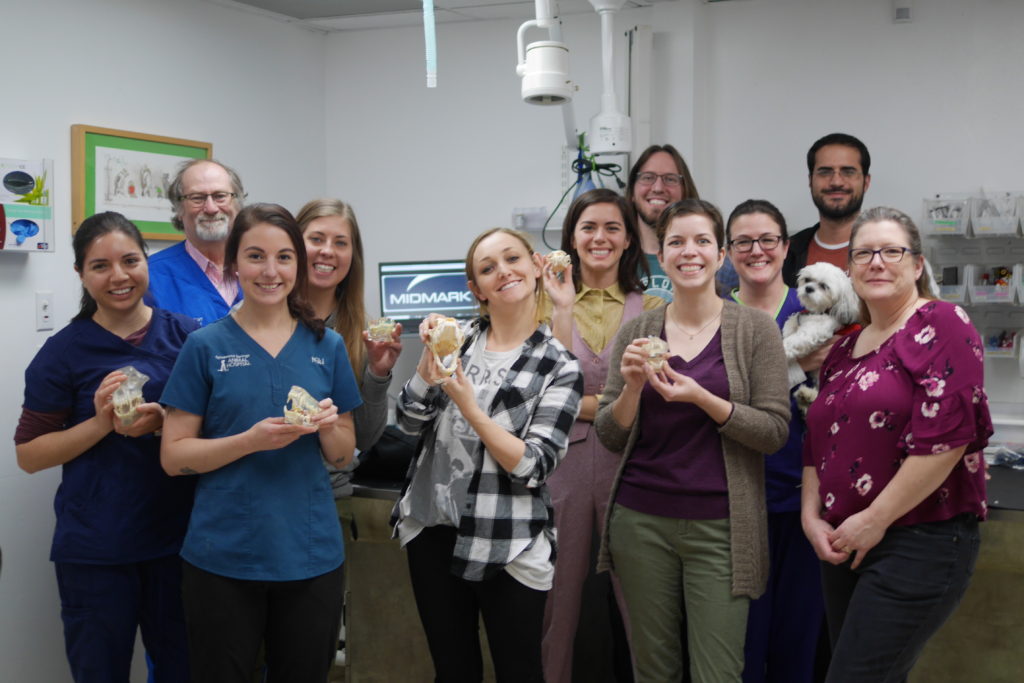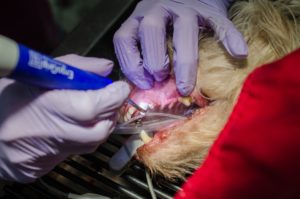You may have noticed flyers at your local pet store offering Non-Anesthetic Dental cleanings, also called NAD. It sounds like a great alternative to the scary anesthetic procedure your veterinarian has been recommending for your pet. Who would want to put their dog or cat under anesthesia when they can get the same thing for less stress and lower cost? The truth of the matter is that NAD does not compare to anesthetized veterinary dental cleanings when it comes to benefit and value.
Importance of Pet Oral Health
Dentistry is a growing field in the veterinary world, as more and more research points to the importance of oral health in animals. In a perfect world, we would be able to brush our pet’s teeth twice a day, just like we do! The reality is that it’s hard to achieve this level of care due to lack of time or cooperation from our pets. Unless you’re brushing your pet’s teeth every day, large amounts of tartar can develop on the surface of their teeth, leading to deeper issues under the surface. As this tartar develops, it encourages growth of bacteria around the gums, causing gingivitis, bone loss, infection, degradation of the tooth, or even tooth loss. Usually the animal continues to eat and act like it feels fine, when, actually, it is suffering from pain caused by these conditions. In the case of severe dental disease, the bacteria in the mouth can even enter the blood stream, traveling to other areas of the body. This can result in damage to the heart, kidneys, liver, or other major organ systems, potentially causing illness and shortening the lifespan of your beloved pet.
Benefits of Anesthetized Comprehensive Dental Cleanings
Regular dental cleanings are important to remove tartar from your pet’s teeth before it starts to cause localized or even systemic health issues. But with several options now available, which should you choose? Veterinarians offer dental prophylaxis or comprehensive dental cleanings, which are performed under full anesthesia. This option is beneficial in multiple ways. With the animal anesthetized, we are able to search and scour every nook and cranny of its mouth which is valuable beyond just cleaning their teeth. Many other issues can develop inside their mouths including tumors, cancer, previously undetected foreign objects that have become lodged, or overgrowth of gum tissue. Hardly any animal would tolerate the handling required to do a thorough oral exam, including looking underneath their tongues. Cleaning the tartar from their teeth, called scaling, also requires them to be completely still. Dentistry tools can be sharp and cause damage if the patient moves too suddenly. Tartar not only develops on the outside of their teeth, but also on the inside and under the gumline-areas that can be very challenging to access in an awake animal. If you thought it takes a long time to clean all 32 of your own teeth, dogs have 42! The cleaning process alone can last 30 minutes or more depending on the size of the animal and the amount of tartar present. Dental radiographs are another important aspect of the dental procedure. They can reveal issues under the gums that are not apparent from just visualization alone. Abscesses, bone loss, periodontitis, resorptive lesions, and root fracture are all examples of things we find on an x-ray even if we didn’t suspect them during the oral exam. While it is easy to ask a human patient to bite and hold the x-ray film in their mouth in just the right way to get a good image, it is impossible to make this request of an animal. So again, ideally the animal needs to be completely anesthetized in order to obtain valuable information of the total oral health of your pet.
Drawbacks to Non-Anesthetic Dentals
The non-anesthetic dental cleaning (NAD) tends to be a more affordable and attractive option for people, but it may not be the best choice. While there is good success for the removal of tartar, it does not come close to the extensive requirements for comprehensive oral health for several reasons. For one, it is uncomfortable for the animal to have tartar removed from under their gumline, which is arguably the most important aspect of a dental cleaning. With that tartar still present, bacteria can accumulate and cause damage to the roots and bone, even though the teeth look clean when you lift your pet’s lips. The NAD does not include the valuable thorough oral examination to assess all the areas of the mouth including under the tongue, allowing serious problems to go undetected. You would not get valuable radiographic images of their teeth during a NAD either, as it can’t be done with the animal awake. Again, issues may lurk under the surface that could cause avoidable pain and more extensive and expensive treatment further down the line. While it may seem like an animal would be less stressed to remain awake instead of being anesthetized, one could argue the opposite. They would need to be restrained for 20-30 minutes in order to complete the cleaning, which can definitely cause them stress. They would also have people handling their mouths and faces for reasons they wouldn’t understand. During an anesthetized cleaning, your pet would receive an injection of an anti-anxiety and pain-relieving drug before they were handled for anything further, a courtesy not offered during a NAD. What happens if there is a problem noticed during a NAD? Well unfortunately, your pet would still need to be referred to your veterinarian to have an anesthetized procedure to fix the issue. This means you end up paying for two different procedures and putting your pet through unnecessary additional stress.
Treatment Plan for Optimal Oral Health
Though the NAD alone does not impart the same beneficial effects, when used in conjunction with an anesthetized comprehensive cleaning, you can improve the overall outcome and reduce long-term expenses related to your pet’s teeth. With some animals who have a greater propensity for tartar buildup or dental disease, our veterinarians still recommend yearly anesthetized cleanings, but then supplementing with a NAD at the 6 month point in between. This is a great way to control the tartar development without sacrificing the value and immense importance of the full comprehensive cleaning once a year. For further information on your pet’s individual oral health needs and recommendations, you can always discuss it with your veterinarian at your pet’s annual physical examination. And remember, Dental Health Month is every February, and Spicewood Springs Animal Hospital offers 10% off dental cleanings for the entire month with a professional and caring staff.





